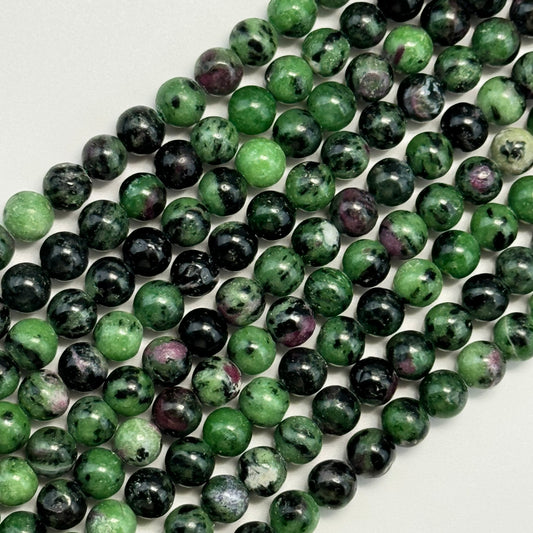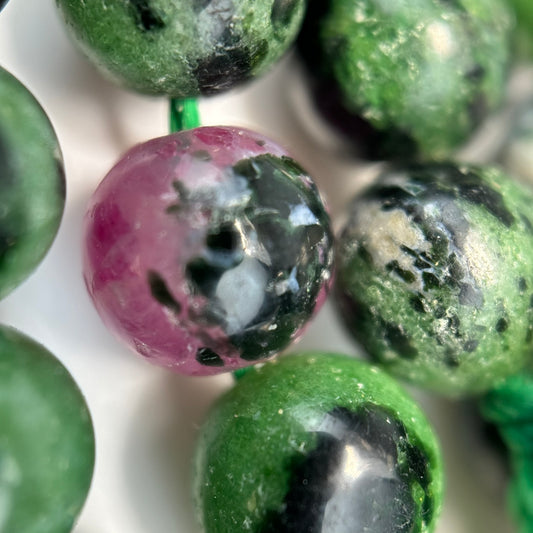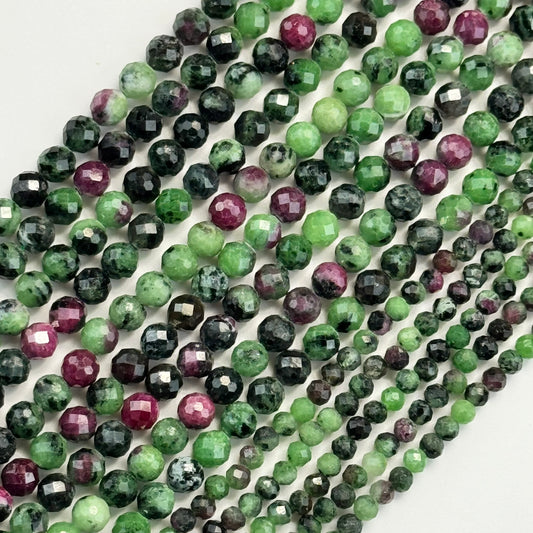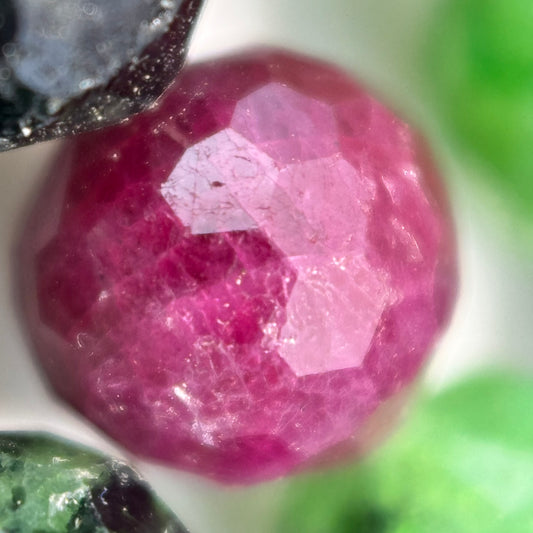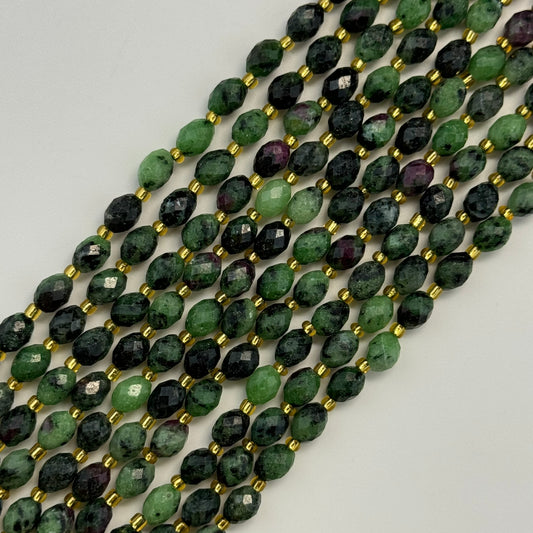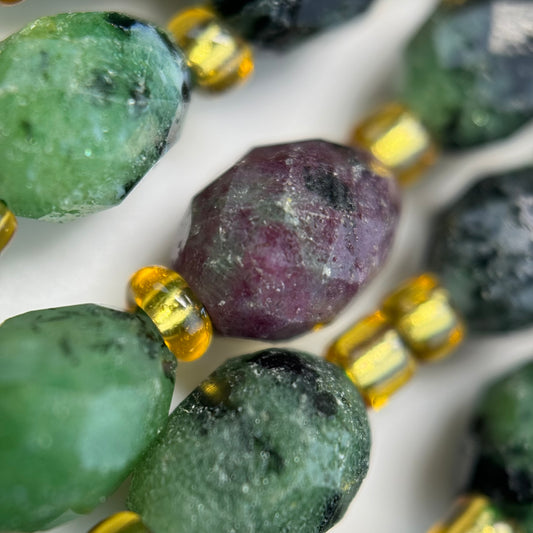Ruby Zoisite: Mineral Composition and Gemological Overview
Ruby Zoisite, also known as Anyolite, is a unique mineral combination consisting of green Zoisite with inclusions of red Ruby and occasional black Tschermakite. This distinctive stone is primarily sourced from Tanzania and is classified under the epidote mineral group. Its Mohs hardness ranges from 6 to 7, offering moderate durability for ornamental and jewelry use.
Gemologically, Ruby Zoisite’s formation occurs when corundum (Ruby) crystallizes within the Zoisite matrix under specific geological conditions. The vibrant green Zoisite contrasts with the deep red Ruby inclusions, making it an admired specimen for collectors and designers alike. Its complex mineral structure showcases nature's intricate crystallization processes, making it a valuable study piece in mineralogy courses and gemology labs.
Meaning of Ruby Zoisite: Metaphysical Interpretations and Cultural Significance
Ruby Zoisite carries rich metaphysical interpretations across cultures. It is believed to harmonize the energy of the heart and the mind, enabling emotional healing and spiritual growth. In traditional crystal healing, this stone is known to promote vitality, courage, and motivation, especially during personal transformation periods.
Many cultures view Ruby Zoisite as a stone of rebirth and balance, combining the energizing power of Ruby with the stabilizing influence of Zoisite. Healers often recommend it for overcoming grief or emotional trauma, making it a popular stone in meditation and energy therapy practices.
Ruby Zoisite Healing Properties: Energetic Effects and Crystal Therapy Insights
In crystal therapy, Ruby Zoisite is known for its potent healing properties, believed to boost the immune system and enhance energy circulation within the body. Practitioners often place it on the heart chakra to stimulate compassion and promote overall physical and emotional healing.
Energetically, this stone combines the life force energy of Ruby with Zoisite's growth and fertility vibrations, creating a synergy that encourages healing on multiple levels. It is frequently used in reiki and chakra balancing sessions to dissolve negative patterns and renew optimism.
Ruby Zoisite Benefits: Scientific Perspectives and Holistic Uses
From a holistic perspective, Ruby Zoisite is valued for its potential to inspire creativity, passion, and spiritual awakening. Users often report heightened focus and motivation when working with this stone during intention-setting or personal development practices.
While scientific studies do not confirm crystal healing claims, gemologists and mineralogists appreciate Ruby Zoisite for its unique formation and educational value. Its distinct mineral composition makes it a vital specimen in geology labs, while its aesthetic benefits support artisans and jewelers in crafting meaningful designs.
Ruby Zoisite Color: Chemical Causes of Chromatic Variations
The vibrant colors of Ruby Zoisite are due to its unique chemical structure. The green Zoisite derives its color from trace amounts of vanadium and chromium, while the red Ruby inclusions owe their rich hue to chromium within the corundum matrix. The presence of black Tschermakite adds visual depth to the stone’s appearance.
This combination results in an eye-catching gem with contrasting yet harmonious colors, making Ruby Zoisite a popular choice for statement jewelry pieces and ornamental carvings. Understanding these chromatic variations helps gemologists in accurate identification and grading of the mineral.
Ruby Zoisite vs Ruby Sapphire: Mineralogical Comparison and Classification
Although Ruby Zoisite contains Ruby, it is distinct from Ruby Sapphire combinations. Ruby is a red variety of corundum, while sapphire refers to any other corundum color, predominantly blue. In Ruby Zoisite, the Ruby inclusions are embedded within the Zoisite matrix, creating a natural hybrid mineral rather than a blended corundum gemstone.
This mineralogical distinction is crucial for gem classification. While Ruby and Sapphire are purely corundum minerals, Ruby Zoisite combines corundum with Zoisite, forming an entirely different stone with unique physical, optical, and energetic properties.
Ruby Zoisite in Jewelry Making: Lapidary, Design Applications, and Durability Factors
In jewelry making, Ruby Zoisite is highly sought after for cabochons, beads, and ornamental carvings. Its attractive color combinations make it ideal for statement necklaces, bracelets, and earrings. Lapidarists typically cut Ruby Zoisite into cabochons to highlight the contrasting hues of green and red inclusions.
Due to its moderate hardness, Ruby Zoisite requires careful setting to prevent scratches or impact damage. Jewelers often use protective designs or secure bezel settings to enhance its durability while showcasing its vibrant aesthetic appeal in artistic creations.
Ruby Zoisite Beads: Formation, Gemstone Grading, and Jewelry Crafting Use
Ruby Zoisite beads are created by shaping and polishing the rough stone into spherical or faceted forms, preserving its unique green and red patterns. These beads are popular in mala necklaces, healing bracelets, and artisan jewelry pieces for their striking natural beauty and spiritual associations.
Grading of Ruby Zoisite beads depends on color vibrancy, Ruby inclusion visibility, and polish quality. High-grade beads exhibit an intense green Zoisite matrix with prominent, well-distributed Ruby areas, offering exceptional aesthetic value for jewelry makers and collectors alike.
Ruby Zoisite in Reza Gem Collection: Selection, Quality Standards, and Sourcing
At Reza Gem Collection, Ruby Zoisite is carefully sourced from reputable mines in Tanzania to ensure authentic mineral composition and ethical mining practices. Each piece is inspected for vibrant coloration, structural integrity, and lapidary potential before making it to the showroom.
Reza Piroznia, as an experienced gemologist, selects Ruby Zoisite specimens that meet high-quality standards for jewelry design and metaphysical use. Whether crafted into beads, cabochons, or carvings, Ruby Zoisite remains one of Reza Gem Collection’s most admired stones for both collectors and jewelry artisans.
Frequently Asked Questions
What is Ruby Zoisite?
Ruby Zoisite, also known as Anyolite, is a natural combination of green Zoisite and red Ruby inclusions with occasional black Tschermakite. This unique mineral blend is primarily sourced from Tanzania and admired for its vibrant contrasting colors.
Where is Ruby Zoisite found?
The main source of Ruby Zoisite is the Longido mining district in Tanzania, Africa. It is rarely found in other regions, making Tanzanian deposits highly significant in the global gemstone market.
Is Ruby Zoisite a natural stone?
Yes, Ruby Zoisite is a completely natural stone formed when corundum (Ruby) crystals grow within the Zoisite matrix under geological heat and pressure conditions. It is not a man-made composite.
What is the meaning of Ruby Zoisite?
Ruby Zoisite symbolizes harmony between passion and patience, combining the energizing qualities of Ruby with the calming, growth-oriented energies of Zoisite. It is often used to balance emotional and mental states.
What are the healing properties of Ruby Zoisite?
Crystal healers believe Ruby Zoisite promotes vitality, courage, and emotional healing. It is used to strengthen the heart chakra, enhance life force energy, and transform negative patterns into growth-oriented perspectives.
How is Ruby Zoisite used in jewelry?
Ruby Zoisite is cut into cabochons, beads, and carvings for use in necklaces, bracelets, earrings, and rings. Its striking color combination makes it a preferred stone for statement jewelry and artistic lapidary pieces.
Is Ruby Zoisite durable for daily wear?
With a Mohs hardness of 6-7, Ruby Zoisite offers moderate durability for daily wear. It should be set securely to prevent scratches or chipping, especially in rings or bracelets exposed to impact.
What is the difference between Ruby Zoisite and Ruby in Sapphire?
Ruby Zoisite is a combination of Ruby within a Zoisite matrix, while Ruby in Sapphire refers to color variations within corundum crystals. They are distinct mineral formations with different physical and gemological properties.
How can you tell if Ruby Zoisite is real?
Authentic Ruby Zoisite shows visible red Ruby inclusions within a green Zoisite matrix, sometimes with black Tschermakite streaks. Certified gemological testing for refractive index and mineral composition confirms authenticity.
Does Ruby Zoisite have metaphysical benefits?
Yes, in metaphysical practices, Ruby Zoisite is believed to balance emotional energy, promote spiritual growth, enhance creativity, and support recovery from grief or trauma. It is widely used in crystal healing and meditation.
How is Ruby Zoisite formed geologically?
Ruby Zoisite forms when Ruby corundum crystals crystallize within Zoisite-rich metamorphic rocks under intense heat and pressure, resulting in the unique fusion of these two minerals in a single stone.
What colors does Ruby Zoisite have?
Ruby Zoisite features a vivid green Zoisite matrix with dark green to black Tschermakite inclusions and bright red Ruby areas, creating a striking natural color palette used widely in jewelry and carvings.
Can Ruby Zoisite be used in meditation?
Yes, Ruby Zoisite is commonly used in meditation to balance the heart and mind, enhance intuitive insights, and encourage emotional healing. It is often placed on the heart chakra during energy work sessions.
What are Ruby Zoisite beads used for?
Ruby Zoisite beads are used in crafting mala necklaces, healing bracelets, and artisan jewelry. They are valued for their natural aesthetic and spiritual associations in gemstone beadwork and jewelry making.
What is the chemical composition of Ruby Zoisite?
Ruby Zoisite’s chemical formula combines Zoisite (Ca2Al3(SiO4)(Si2O7)O(OH)) with Ruby (Al2O3) inclusions. The green color is due to vanadium and chromium in Zoisite, while Ruby’s red hue comes from chromium within corundum.
Is Ruby Zoisite rare?
Ruby Zoisite is considered relatively rare because it is primarily found in a specific region of Tanzania. High-quality specimens with vibrant Ruby inclusions are especially sought after by collectors and designers.
How do you care for Ruby Zoisite jewelry?
To care for Ruby Zoisite jewelry, clean it with lukewarm water and a soft cloth. Avoid harsh chemicals, ultrasonic cleaners, or prolonged sun exposure, and store it separately to prevent scratching from harder stones.
What is Ruby Zoisite called in gemology?
In gemology, Ruby Zoisite is sometimes referred to as Anyolite, derived from the Maasai word 'anyoli' meaning green. This term highlights its cultural origin and natural green coloration combined with Ruby inclusions.
Can Ruby Zoisite be treated or enhanced?
Ruby Zoisite is generally untreated. However, some low-grade stones may be dyed to enhance their green color. Reputable sellers provide natural, untreated Ruby Zoisite with certifications for authenticity.
Does Reza Gem Collection offer Ruby Zoisite?
Yes, Reza Gem Collection offers carefully selected Ruby Zoisite beads, cabochons, and carvings sourced ethically from Tanzania. Each piece is inspected by Reza Piroznia for quality, color vibrancy, and mineral authenticity.
